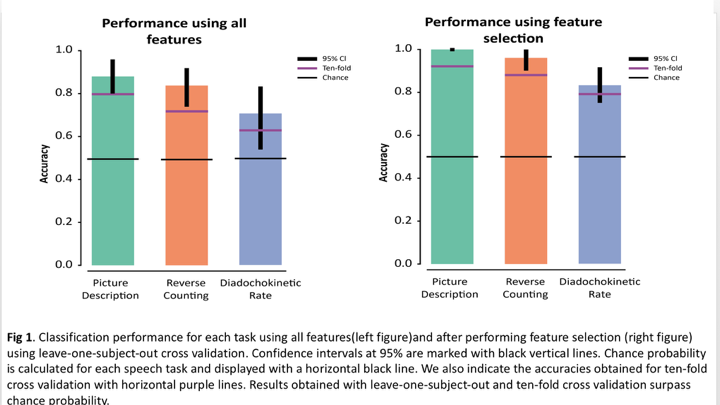Session Information
Date: Sunday, October 7, 2018
Session Title: Technology
Session Time: 1:45pm-3:15pm
Location: Hall 3FG
Objective: The aim of this study is to assess the use of semantic, prosodic, and acoustic speech features to better characterize PD signs with respect to patient reported on/off states.
Background: Parkinson’s disease (PD) is a progressive neurodegenerative disease affecting more than 10 million people. The standard treatment is dopamine replacement therapy, which mitigates but does not cure the most common signs of the illness. Time when patients feel that their symptoms are controlled is referred to as “on” time. Time when the medication does not control symptoms is referred to as “off” time. Examinations performed by neurologists, and standardized neurological assessment instruments, such as the UPDRS, enable monitoring of the longitudinal course of the disease, but these exams are time consuming, subjective, and ultimately impractical for capturing subtle or moment-to-moment fluctuations. They also are not able to capture data outside of the clinic in the patients’ day-to-day life, where the true impact of the disease is experienced.
Methods: 25 subjects with PD were recruited and asked to perform 3 different speech tasks: 1) describe a picture 2) repeat the syllables “pa-ta-ka” and 3) reverse counting. These tasks were performed in both “on” and “off” states. To characterize PD speech, we extracted acoustic, prosodic, and semantic features then applied machine learning techniques to evaluate the ability of these features to predict the PD medication response state.
Results: Classification performance was measured using leave-one-subject-out cross validation. We obtained accuracy rates of 0.88, 0.71 and 0.84 for task 1,2 and 3, respectively. After performing feature selection we obtained an accuracy of 100%. This resulted in the high classification accuracy on the 3 different tasks shown in Fig 1.
Conclusions: We have shown that speech-based features are highly correlated with subject reported L-DOPA “on/off” states. Given that the highest performance was obtained with a very naturalistic task (picture description), our results support the possibility of accurate, non-burdensome and high-frequency monitoring of medication effects based on collection and analysis of natural speech.
To cite this abstract in AMA style:
R. Norel, C. Agurto, S. Heisig, R. Ostrand, B. Ho, V. Ramos, H. Zhang, K. Erb, J. Rice, G. Cecchi. Identification of L-DOPA “on/off” states using speech-based analysis in Parkinson’s disease subjects [abstract]. Mov Disord. 2018; 33 (suppl 2). https://www.mdsabstracts.org/abstract/identification-of-l-dopa-on-off-states-using-speech-based-analysis-in-parkinsons-disease-subjects/. Accessed December 23, 2025.« Back to 2018 International Congress
MDS Abstracts - https://www.mdsabstracts.org/abstract/identification-of-l-dopa-on-off-states-using-speech-based-analysis-in-parkinsons-disease-subjects/

